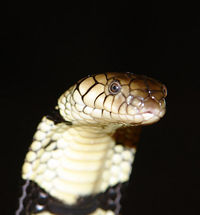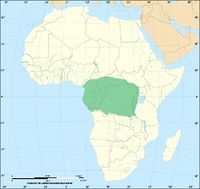Banded water cobra
| Banded water cobra | ||||||||||||||||||||
|---|---|---|---|---|---|---|---|---|---|---|---|---|---|---|---|---|---|---|---|---|
 Banded water cobra
| ||||||||||||||||||||
| Scientific classification | ||||||||||||||||||||
| ||||||||||||||||||||
| Binomial name | ||||||||||||||||||||
| Naja annulata Peters, 1876[1] | ||||||||||||||||||||
 Distribution of the banded water cobra
| ||||||||||||||||||||
| Synonyms | ||||||||||||||||||||
|
The Banded water cobra (Naja annulata), also commonly known as the Ringed water cobra is a species of venomous snake belonging to the Elapidae family and is native to sub-Saharan Africa. This species was formerly under the genus Boulengerina, but more recent research by Wallach et al has shown that Boulengerina is actually a subgenera and Boulengerina annulata is a synonym of Naja annulata.[2] This species has two subspecies, Naja annulata stormsi and the nominate subspecies, Naja annulata annulata which is described in this article.
Etymology
The banded water cobra was described by German naturalist Wilhelm Peters in 1876. The generic name naja is a Latinisation of the Sanskrit word nāgá (नाग) meaning "cobra". The specific epithet annulata is derived from the Latin word "annulus" which means ring or band.[3]
Description
It is a large, heavy bodied snake with a short, broad and flat with an indistinct canthus and distinct from the neck. It has a medium sized dark eye with a round pupil. The body is cylindrical, the tail is long. The scales are smooth and glossy, in 21-23 rows at midbody. Adults grow to an average of 1.4 m (4.59 ft) to 2.2 m (7.22 ft) in length, but they can grow to a maximum of 2.7 m (8.86 ft). The tail is long and can measure about 25% o the total length.[4] Scales are smooth, indicating the largely aquatic life of this species. This species is capable of spreading a narrow, yet impressive hood. Body colours can be quite variable but are mostly glossy brown, grayish brown, or reddish brown with black bands all along the body - from the neck till the tip of the tail tip. These black bandings may fade out and stay as dark patches over the body as the snake ages. Some specimens have a shiny black tail. The ventral side is pale yellow or creamy in colour but some specimens may have bright orange ventral scales. The tail is wholly black.[5][6]
Scalation
Dorsal scales on the midbody 21-23, ventrals 210-223, subcaudals 54-66 (paired), Anal scale is entire, upper labials 7, upper labials entering the eye 3 (sometimes 4), preoculars 1, postoculars 2, lower labials 9 (sometimes 8).
Distribution and habitat
This species of snake is found in parts of central and western Africa. Its occurs in Cameroon, Central African Republic, Democratic Republic of Congo, Republic of Congo, Equatorial Guinea, Gabon, Rwanda, and the province of Cabinda in Angola. It is largely an aquatic species and rarely found far away from water. It can be found along lakes and rivers in forest and well wooded savanna terrain where their is sufficient cover.[5] Most common along lowland forested, bushy or wooded banks of lakes, rivers, and streams.[6]
Behavior and diet
It is a secretive species and is seldom encountered by humans. This species of snake is active by day and night, though it is usually more active by day. It is largely an aquatic snake which spends most of its time in the water. It is an excellent swimmer and is capable of remaining under water for up to ten minutes and diving to depths of 25 m (82.02 ft). The banded water cobra along with the Congo water cobra are the most aquatic of all cobras in the genus Naja. It is a slow mover on land and it tends to hide amongst rocks, in holes or over-hanging tree roots at the shore line. Also makes use of any man-made structures such as bridges and jetties to hide. It is a generally non-aggressive snake. If approached in water it will swim away swiftly and on land will attempt to escape into water. If threatened on land it will rear up and spread its narrow, yet prominent hood and it may hiss loudly, but it tends not to make any forward movements. It will only bite when provoked.[5][4]
It preys almost exclusively on fish and probably eels.[5] It may also prey on frogs, toads, and other amphibians.[6]
Venom
The venom of this species is not well studied, but it is believed that the venom is dangerously neurotoxic, like that of most elapids. A study listed the intraperitoneal (IP) LD50 of this species at 0.143 mg/kg.[7] Brown (1973) listed the intravenous LD50 at 0.2 mg/kg.[8] Subcutaneous LD50 values tend to be less toxic than both intraperitoneal and intravenous injection median lethal dose values almost all of the time, so it's safe to assume that the subcutaneous LD50 value for this species is less toxic than its intraperitoneal and intravenous values.[8][9]
Venoms of the water cobras, were assayed for lethality, proteolytic activity and protein content. Naja annulata annulata and Naja christyi venoms averaged 89% protein and lacked proteolytic activity. The murine intraperitoneal LD50 of N. a. annulata and N. christyi venoms were 0.143 and 0.120 mg/kg, respectively. Polyvalent antivenom produced by the South African Institute of Medical Research neutralized 575 and 200 LD50 of N. a. annulata and N. christyi venoms/ml antivenom, respectively. Cation exchange chromatography resolved four lethal peaks from N. a. annulata venom and six lethal peaks from N. christyi venom. The major lethal peaks (about 12% of total venom protein) were purified further with molecular sieve chromatography and were characterized as 61 (N. a. annulata toxin) and 62 (N. christyi toxin) residue polypeptides with four half-cystines. Elucidation of the complete amino acid sequences indicated that these toxins belonged to the short-chain class of postsynaptic neurotoxins. Short-chain neurotoxins 1 from N. a. annulata and N. christyi had murine intraperitoneal LD50 of 0.052 and 0.083 mg/kg, respectively, and showed over 80% homology with N. nigricollis alpha toxin. Reverse-phase analysis of another peak present in both venoms resolved a toxin that had an N-terminus identical to N. christyi short-chain neurotoxin 1. These fractions also contained toxins readily separable from the short-chain isotoxin by preparative reverse-phase chromatography. Amino acid sequencing of the first 28 residues indicated that both toxins were long-chain neurotoxins with identical N-termini. The LD50 of long-chain neurotoxins 2 from N. a. annulata and N. christyi venoms were 0.086 and 0.090 mg/kg, respectively. The venoms of these little-known elapids have the lowest intraperitoneal LD50 of any African Naja species studied thus far and have high concentrations of potent postsynaptic neurotoxins.[7]
Taxonomy
| Subspecies | Taxon author | Common name | Geographic range |
|---|---|---|---|
| N. a. annulata | (Buchholz Peters, 1876)[1] | Banded water cobra, Ringed water cobra | Cameroon, Central African Republic, Democratic Republic of Congo, Republic of Congo, Equatorial Guinea, Gabon, Rwanda, Cabinda |
| N. a. stormsi | (Dollo, 1886)[1] | Storms water cobra | Burundi, Tanzania |
Cited references
- ↑ 1.0 1.1 1.2 Naja annulata PETERS, 1876 at The Reptile Database. Accessed 12 May 2012.
- ↑ Wallach, V.; Wüster, W. & Broadley, D.G. (2009). In praise of subgenera: taxonomic status of cobras of the genus Naja Laurenti (Serpentes: Elapidae) at Zootaxa. Magnolia Press. Zootaxa 2236: 26–36 pp. ISSN 1175-5334
- ↑ Etymology of the word Annulata at The Reptile Database. Accessed 12 May 2012.
- ↑ 4.0 4.1 Spawls, Stephen (1995). Dangerous Snakes of Africa. London, UK: Blandford Press, 55–56. ISBN 0-7137-2394-7.
- ↑ 5.0 5.1 5.2 5.3 Boulengerina annulata - General Details, Taxonomy and Biology, Venom, Clinical Effects, Treatment, First Aid, Antivenoms. Clinical Toxinology Resource. University of Adelaide. Retrieved on 12 May 2012.
- ↑ 6.0 6.1 6.2 Boulengerina annulata. Armed Forces Pest Management Board. United States Department of Defense. Retrieved on 12 May 2012.
- ↑ 7.0 7.1 Weinstein, Scott A.; James J. Schmidt, Leonard A. Smith (30). "Lethal toxins and cross-neutralization of venoms from the African water cobras, Boulengerina annulata annulata and Boulengerina christyi". Toxicon 29 (11): 1315–1327. PMID 1814007. Retrieved on 12 May 2012.
- ↑ 8.0 8.1 Brown, John H. (1973). Toxicology and Pharmacology of Venoms from Poisonous Snakes. Springfield, IL USA: Charles C Thomas, 80. ISBN 0-398-02808-7.
- ↑ Fry, Dr. Bryan Grieg. LD50 Menu. Australian Venom Research Unit. University of Queensland. Retrieved on 12 May 2012.